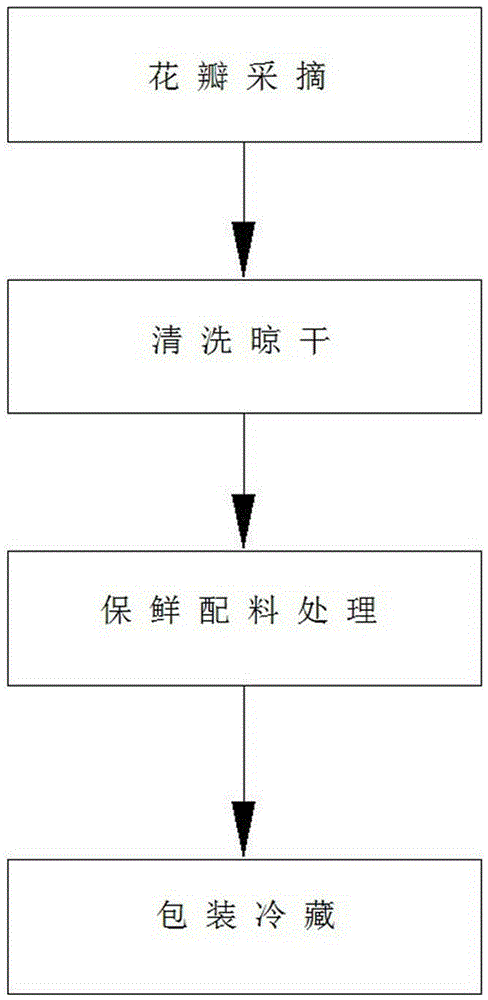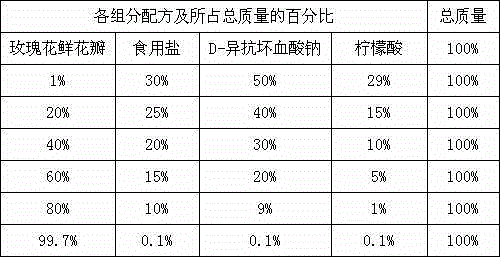Rose petal fresh-keeping formula and fresh-keeping method
A fresh-keeping method and technology for roses, which are applied in the fields of botanical equipment and methods, plant preservation and application, can solve the problems of high fresh-keeping cost, unsuitable fresh-keeping, waste of space, etc., and achieve low fresh-keeping cost and small footprint. Effect
- Summary
- Abstract
- Description
- Claims
- Application Information
AI Technical Summary
Problems solved by technology
Method used
Image
Examples
Embodiment 1
[0019] A rose petal preservation formula, comprising 1% of the total mass percentage of rose petals, 30% of the total mass percentage of edible salt, 50% of the total mass percentage of D-sodium erythorbate, and 50% of the total mass percentage of citric acid 19%.
[0020] A method for preserving freshness of rose petals, comprising picking petals, washing and drying, processing fresh-keeping ingredients, packaging and refrigerating, wherein the petals are washed and dried after picking, fresh-keeping ingredients are processed after cleaning and drying, and fresh-keeping ingredients are packaged and refrigerated after being processed. , the picking of the petals is to cut off the branches after the fresh roses are picked, and after the branches are cut off, the petals are separated from the flowers to obtain pure rose petals, and the rose petals are selected and screened according to the size of the petals. Classify, wash and dry the rose petals obtained by picking the petals,...
Embodiment 2
[0022] A rose petal preservation formula, comprising 1% of the total mass percentage of rose petals, 30% of the total mass percentage of edible salt, 50% of the total mass percentage of D-sodium erythorbate, and 50% of the total mass percentage of citric acid 19%.
[0023] A method for preserving freshness of rose petals, comprising picking petals, washing and drying, processing fresh-keeping ingredients, packaging and refrigerating, wherein the petals are washed and dried after picking, fresh-keeping ingredients are processed after cleaning and drying, and fresh-keeping ingredients are packaged and refrigerated after being processed. , the picking of the petals is to cut off the branches after the fresh roses are picked, and after the branches are cut off, the petals are separated from the flowers to obtain pure rose petals, and the rose petals are selected and screened according to the size of the petals. Classify, wash and dry the rose petals obtained by picking the petals,...
Embodiment 3
[0025] A rose petal preservation formula, comprising rose petals accounting for 60% of the total mass percentage, edible salt accounting for 10% of the total mass percentage, D-sodium erythorbate accounting for 20% of the total mass percentage, and citric acid accounting for the total mass percentage 10% of.
[0026] A method for preserving freshness of rose petals, comprising picking petals, washing and drying, processing fresh-keeping ingredients, packaging and refrigerating, wherein the petals are washed and dried after picking, fresh-keeping ingredients are processed after cleaning and drying, and fresh-keeping ingredients are packaged and refrigerated after being processed. , the petals are plucked after the fresh roses are picked and the branches are cut off, and after the branches are cut off, the petals are separated from the flowers to obtain pure rose petals, and the rose petals are selected and screened according to the size of the petals. Classify, wash and dry the...
PUM
 Login to View More
Login to View More Abstract
Description
Claims
Application Information
 Login to View More
Login to View More - R&D
- Intellectual Property
- Life Sciences
- Materials
- Tech Scout
- Unparalleled Data Quality
- Higher Quality Content
- 60% Fewer Hallucinations
Browse by: Latest US Patents, China's latest patents, Technical Efficacy Thesaurus, Application Domain, Technology Topic, Popular Technical Reports.
© 2025 PatSnap. All rights reserved.Legal|Privacy policy|Modern Slavery Act Transparency Statement|Sitemap|About US| Contact US: help@patsnap.com


